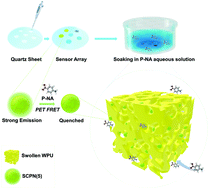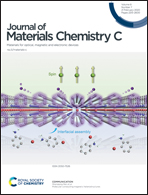Fluorescent electronic tongue supported with water-borne polyurethane for the discrimination of nitroaromatics in aqueous solution†
Abstract
Fluorescent electronic tongues are designed for the quick discrimination of nitroaromatics in aqueous solution through fluorescence quenching of soluble conjugated polymeric nanoparticle (SCPN) arrays supported with water-borne polyurethane. The quenching efficiencies dominantly depend on the overlap of the absorbance spectra of the nitro-analytes and the emission spectra of the SCPNs, as well as the LUMO level of the nitro-analytes. The unique quenching responses towards eight nitroaromatics were recorded by reading the RGB values and then the differences were analyzed by linear discriminant analysis (LDA). The fluorescent electronic tongues showed high sensitivity towards the nitroaromatics in a relatively low concentration of 0.1 mM with rapid response time (within minutes of exposure time). In the prediction test of unknown nitro-analytes via the leave-one-out cross-validation method, the evaluation accuracy reached 100% within the test scope, suggesting that the fluorescent electronic tongues in this work are promising for quick sensing and identifying nitroaromatics in wastewater for field use.



 Please wait while we load your content...
Please wait while we load your content...